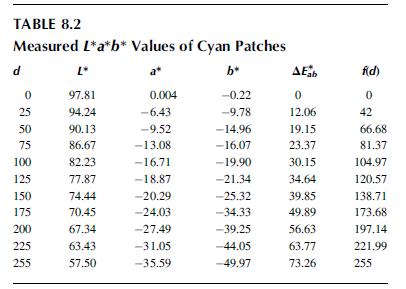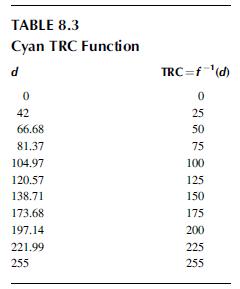Assume that N11 Cyan patches with digital counts of 0, 25, 50, 75, 100, 125, 150, 175,
Question:
Assume that N¼11 Cyan patches with digital counts of 0, 25, 50, 75, 100, 125, 150, 175, 200, 225, and 255 are printed on a color digital printer. The measured L*a*b* values of these 11 patches and their corresponding DE from paper are shown in Table 8.2. Note that the first row, which corresponds to CMYK¼
[0 0 0 0], is the paper white. Therefore, all the DE values are measured with respect to this reference. In practice, the L*a*b* of different spots on the paper can be measured and the average of all these L*a*b* values used as the reference paper white to avoid errors in the measurement process. The function f
(d) is obtained by dividing the DE values by its maximum and multiplying the results by 255. The function is shown in the last column of Table 8.2. The TRC is obtained by finding the inverse of the function f(d). The inverse can be simply obtained by interchanging the dependent and independent variables as shown in Table 8.3. Also see Section 9.9 for additional information about finding an inverse for different conditions. The TRC for the digital counts between the data points of Table 8.3 is obtained by curve fitting or interpolation. The function f
(d) and the resulting TRC for the cyan channel are shown in Figure 8.4. In this figure, the nodes represent the measured points and the solid curve is obtained with linear interpolation. A higher-order interpolation approach can be adopted based on the need.


Step by Step Answer:

Control Of Color Imaging Systems Analysis And Design
ISBN: 9781138112278
1st Edition
Authors: Lalit K. Mestha






